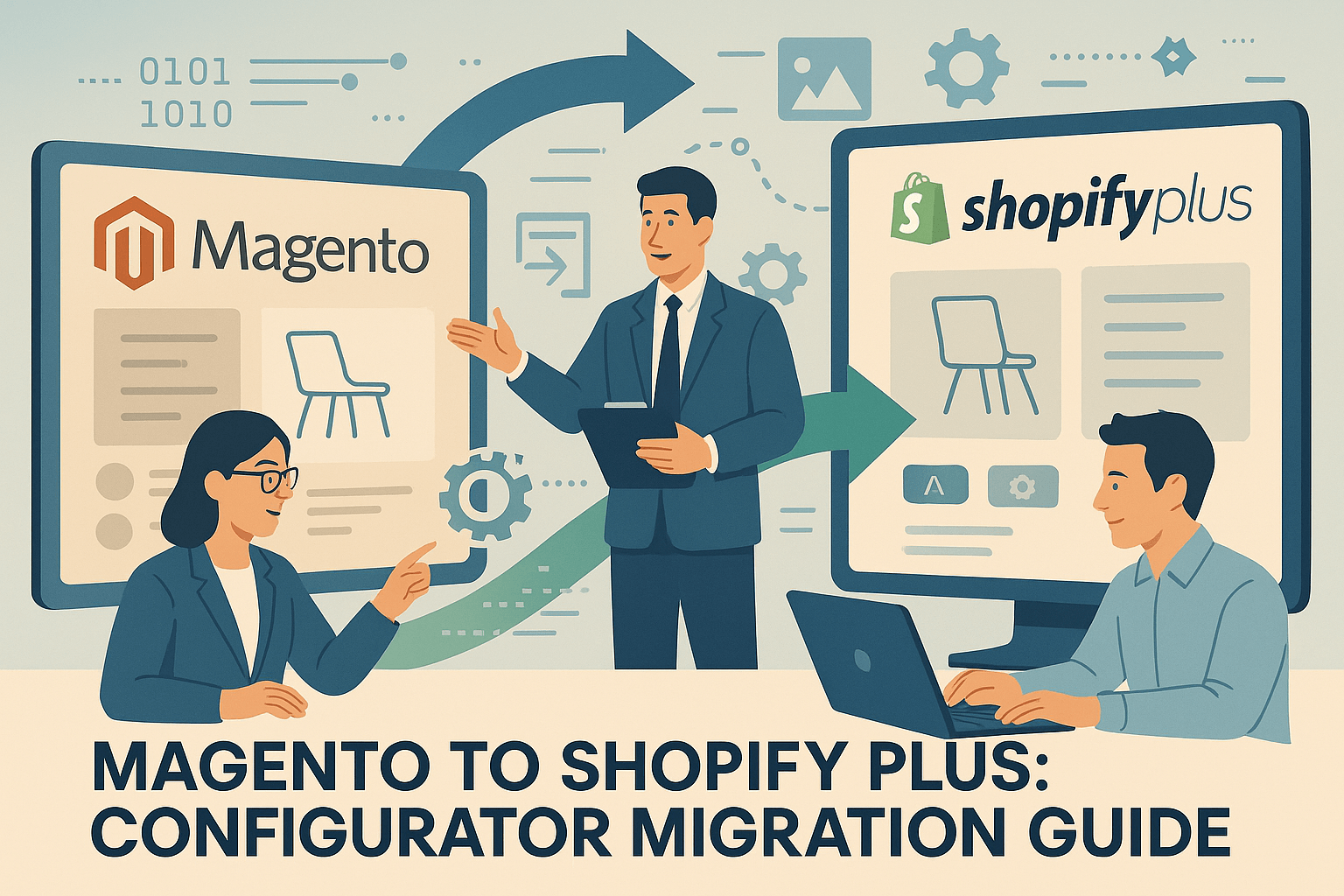For manufacturers, especially in the industrial space, product configurators aren’t just a nice-to-have; they’re the beating heart of the entire sales machine.
If you’re selling custom tools, multi-component systems, or made-to-order machinery, then your configurator isn’t just part of the process — it is the process. It decides what gets built. It shapes how engineers, buyers, and distributors interact with your product and your brand. So when it’s time to move to a new platform, that configurator becomes the wall.
Magento may be outdated, clunky, and expensive to maintain, but it’s flexible. Its open-source architecture made it easy — or at least possible — to wire in deep logic, dependency rules, and configuration conditions that sales teams rely on. That’s why many manufacturers have stayed on it longer than they’d like. Because the fear is real: move to a platform like Shopify Plus, and you risk losing the very functionality your business depends on.
And for too many, that fear becomes fact.
We’ve seen it too often: rich configurators reduced to basic dropdowns. Smart logic erased. Quoting flows are broken. Sales teams left frustrated and scrambling. It’s not that Shopify can’t handle complexity—it just expects you to handle it differently. The logic isn’t buried in the core. It’s structured around it.
Shopify Plus can absolutely support complex configurators — but only if you architect it for how your logic actually works.
This guide shows you how to reengineer your configurator for a new platform like Shopify Plus, without losing control of your Shopify account or backend logic the right way, the first time.
We’re going to show you exactly how to migrate a complex configurator from Magento to Shopify Plus for a successful migration that preserves every feature your Shopify store needs to function flawlessly. You’ll learn what breaks if you get it wrong, how to preserve logic and data, what tech stack to use, and how to reengineer your configuration experience for faster quoting, cleaner UX, and full backend compatibility.
This isn’t a generic migration checklist. This is a strategic, engineering-level roadmap for manufacturers who can’t afford to lose a single rule, variant, or customer configuration.
The High-Stakes Problem with Configurator Migration
Switching platforms is never simple. But if your sales process depends on a rules-driven configurator, the risk isn’t just technical — it’s existential.
Most ecommerce platforms weren’t built with logic-based configuration in mind, and it shows. Magento, for all its quirks, gave industrial teams the freedom to build what they needed: step flows, conditional pricing, component compatibility, CAD file integrations.
It had to be flexible — no plug-and-play system could handle the way industrial products are actually sold.
But that freedom came with a price: bloated code, expensive maintenance, and architecture that’s aging out fast. And as Magento 2.4 nears end-of-life, with support thinning out, the need to migrate Magento while preserving data integrity is becoming urgent for more manufacturers.
That’s where Shopify Plus starts to look like both the solution and the next big challenge.
On paper, Shopify checks every box. It’s fast. Secure. Scalable. But that’s not what keeps decision-makers up at night. The concern is configurator logic.
How do you preserve a logic-heavy, deeply engineered sales flow on a platform that wasn’t built for conditional build paths, dynamic variant generation, or API-driven quoting?
That’s where most teams freeze. Not because they want to — but because they can’t afford to get it wrong.
Shopify plays a different game. You don’t bury logic in the core platform. You build services around it — apps, APIs, headless UIs — all structured around a clean, stable commerce engine.
Done right, the result feels like an upgrade: faster, leaner, easier to maintain, and just as powerful when it comes to rules, pricing, and quoting UX.
Done wrong?
You get a broken experience. Quotes slow down. Reps lose confidence. Customers lose trust. Your team starts looking backward.
And by the time you’re live, it’s too late — fixing it is 10x harder, messier, and more expensive than building it right from the start.
This is why configurator migrations aren’t design problems. They’re infrastructure transitions.
If your configurator controls quoting and fulfillment, it’s not a feature — it’s your revenue infrastructure. And if you migrate without preserving it, you’re not moving forward. You’re dismantling your sales engine with a smile. You can’t afford to treat it like a theme.
Don’t risk a broken configurator. Request a quote for Magento to Shopify migration and let’s build it right, the first time.
The Three Core Challenges in Migrating a Configurator
When most manufacturers think about ecommerce migration, the conversation tends to start with design and end with data. If your configurator does any real work, you’re not just migrating structure—you’re migrating behavior. Decisions, dependencies, and system signals that tie directly to quoting, trust, and fulfillment
And not surface-level logic — deep, layered, business-critical logic. The kind that lives in the space between screens, inside component relationships, pricing rules, quote conditions, and fulfillment flows.
If your configurator is even moderately complex, there are three places where it can break — and if you miss even one, your migration fails. Not just technically. Financially.
Let’s walk through them.
1. Product Logic and Rules
This is the foundation.
Your configurator isn’t just a UI. It’s a logic engine — the part of your ecommerce stack that dictates:
- Which components are compatible
- Which options cancel others out
- What pricing modifiers get triggered
- How selections get translated into SKUs or build instructions
On Magento, this logic is often hardcoded into backend modules. That worked — because Magento lets you go deep.
But on Shopify, this logic needs to live outside the platform core. You externalize it — into a structured app, a logic layer, or headless middleware that talks to Shopify’s product model in real time.
And this is where most migrations fall apart.
The logic gets flattened. Dropdowns replace dynamic builders. Pricing rules vanish. Validation disappears. Suddenly, your powerful configuration flow is reduced to a glorified form, and sales suffer immediately.
Magento data — including embedded logic, Magento products, and Magento categories — rarely imports cleanly into Shopify without major restructuring.
You didn’t lose your data. You lost your logic.
That’s harder to spot — and harder to fix.
2. User Experience and Interaction Flows
Industrial buyers don’t “browse.” They build.
Which is why your configurator probably includes:
- Multi-step guided flows
- Real-time validation
- Visual previews or technical diagrams
- Save-and-return behavior for repeat quoting
These experiences weren’t accidental. They were engineered for the way B2B buyers think logically, stepwise, and with precision.
But during migration, this is often treated like a design problem. You’re not redesigning a website. You’re transplanting a brain into a new body, while the business keeps running.
The default Shopify theme isn’t designed to create a user-friendly interface for a logic-heavy online store, especially when replacing a Magento configurator. If you rely on native variant pickers, you’re not migrating your configurator, you’re just deleting it.
To preserve a logic-driven UX, you need a flexible frontend: React, Next.js, or Hydrogen. Something that can mirror your current flow while giving you room to improve it.
Because your UX is not just about aesthetics. It’s the sales engine’s cockpit.
3. Data Flow and Backend Systems
Even if you preserve the frontend experience and recreate the logic, if your data doesn’t flow to the right systems, the whole thing breaks.
This is the part most teams underestimate.
Because your configurator isn’t just a tool for quoting. It’s connected to:
- Customer accounts
- Saved builds
- ERP systems for fulfillment
- CRMs and CPQs for quoting approval
- SKU and BOM outputs
- Tax and shipping systems
Even if the frontend works, your migration fails if the output doesn’t feed the rest of your stack. That means importing products via CSV files, transferring product images and media folders securely, and syncing store data across all systems.
Ask yourself:
- Can your new system re-generate a quote from a saved build?
- Will it push custom configurations into ERP with clean formatting?
- Can it sync with your quoting logic in HubSpot, Salesforce, or whatever CPQ you use?
- Will a complex build convert cleanly into a Shopify order with all metadata preserved?
If the answer isn’t yes across the board, you’re building a configurator-shaped UI that doesn’t connect to your business logic.
And in B2B? That’s worse than no configurator at all.
Miss even one layer—whether it’s logic, interaction, or system flow—and the whole thing breaks. Quietly at first. Then all at once. You’re setting yourself up to lose revenue, frustrate your sales team, and damage buyer trust.
And once that trust breaks, it’s not just your configurator you’ll be rebuilding.
It’s your reputation.
Here’s the table of Three Core Challenges in Migrating a Configurator:
| Configurator Layer | What Breaks If Ignored | Business Impact |
| Product Logic & Rules | Incompatible selections, broken pricing | Incorrect orders, quoting delays |
| UX & Frontend Behavior | Clunky interface, missing steps | Buyer confusion, lower conversion |
| Data Flow & Integrations | Quotes don’t sync, ERP/BOM mismatch | Fulfillment errors, internal chaos |
What Breaks When You Don’t Plan for These
If you don’t plan for configurator logic, UX flows, and backend data mapping from day one, you’ll lose momentum. And in B2B, momentum is everything.
We’ve seen it happen firsthand. A brand invests six figures in a Shopify Plus migration. The frontend looks clean, the pages load fast, and everyone high-fives during UAT. But then the sales team gets in… and the configurator? It’s not a configurator anymore. It’s a glorified dropdown list. No validation logic. No compatibility rules. No visual preview. Just friction.
You know what happens next?
- Quotes slow down
- Support tickets spike
- Sales teams stop trusting the platform
- Customers call asking, “Where’s the old builder?”
And leadership panics—because conversion tanks, NPS drops, and the platform they were sold as “next-gen” feels like a downgrade.
This isn’t a theoretical risk. It’s a pattern.
We’ve rebuilt these botched migrations. And let me tell you, reverse-engineering configurator logic after the fact, once the new platform is live, is expensive and messy. You’re patching holes under pressure, rebuilding trust with customers who already noticed the cracks, and explaining to your internal team why the new system doesn’t work better than the old one.
The irony? Most of these disasters are preventable.
They happen when migration is treated as a frontend design refresh or an ecommerce “lift and shift,” instead of what it is: a logic architecture transition. Your configurator is not a UI layer—it’s a business rules engine. It determines what customers can buy, how orders get built, and whether your backend systems receive clean data. Strip that out or oversimplify it, and the damage compounds fast.
So if your configurator drives quoting, fulfillment, and customer trust, you can’t afford to half-migrate it. You need to move it with precision—or you’ll be rebuilding under pressure later.
The Shopify Plus Migration Stack
Let’s get one thing straight:
Shopify Plus can support complex B2B configurators. It really can.
But not out of the box. And definitely you’re not cloning Magento. You’re building something leaner, modular, and more future-proof—if you respect the difference.
That’s where most migrations go sideways.
If you plan to replicate Magento’s logic-heavy backend using Shopify’s native variants and a drag-and-drop theme builder, you’re going to run into a wall — fast. Shopify’s core, admin interface, and Shopify URL structure aren’t built to hold your logic—they’re designed to host services that listen to it, while keeping your domain stable and secure. It was built for speed, extensibility, and API-first architecture.
And that’s not a flaw.
It’s the opportunity, if you know how to use it.
What you’re really building isn’t a configurator inside Shopify.
You’re building a layered system around Shopify.
Think of Shopify as the engine — fast, stable, well-supported — and your configurator as the cockpit, sensors, control systems, and AI that surround it.
Here’s what that stack looks like when it’s done right.
1. Custom App Layer – Your Logic Engine
This is where your real power lives.
Instead of jamming all your rules into Shopify’s product model, we build a private logic engine — usually in Node.js or Laravel — that handles:
- “If X, disable Y” logic
- Component rules and exceptions
- Dynamic pricing modifiers
- SKU generation, BOM formatting, spec file outputs
It acts as the brain between your user interface and the Shopify checkout. Every choice a buyer makes gets processed, validated, and priced here, long before Shopify sees it.
If Magento were your monolith, this is your upgrade: a clean, externalized, testable layer that you control.
2. Custom Frontend — Not Just a Theme
Shopify’s themes weren’t designed for multi-step workflows or visual spec diagrams.
That’s not a knock. It’s just reality.
We use React — or Shopify’s Hydrogen framework — to build custom frontends that:
- Render configurator steps dynamically
- Validate fields and logic in real time
- Display spec diagrams or previews
- Communicate with your app layer through APIs
This is where your user experience lives. It’s what makes your buyers feel like they’re building something, not filling out a form.
If you skip this and try to use native pickers, the experience falls flat. It might function, but it won’t sell.
3. Shopify Functions + Checkout Extensibility
This is Shopify’s most underrated superpower.
With Functions and Checkout UI Extensions, we can:
- Inject pricing logic directly into checkout
- Validate configurations before payment
- Customize the checkout flow based on user inputs or logic outcomes
- Apply config-based rules (like validation, pricing tiers, discounts) at the exact moment the order is submitted
This is where the polish happens.
No more fragile line-item hacks or post-order patching.
Logic flows all the way through — cleanly, securely, and automatically.
4. Dynamic Product Modeling — The Right Data in the Right Place
Not every configuration needs to be a Shopify variant.
Trying to force every option into Shopify collections or Shopify automated collections leads to chaos, bloated catalogs, slow pages, and frustrated users.
Here’s how we think about modeling:
- Use Shopify variants for simple, inventory-tracked options.
- Use cart line item properties for dynamic inputs that don’t need inventory.
- Use metafields to store configuration output, file attachments, BOM references, or build instructions.
- Use hidden SKUs for complex logic paths or manufacturing workflows that need a static identifier.
This keeps your catalog clean while still tracking every selection, price modifier, and rule in the background.
5. Middleware and Integrations — Sync or Sink
The final layer is integration.
Your configurator isn’t complete until it talks to the rest of your business.
That means syncing with:
- ERP for fulfillment and manufacturing
- CRM for quoting and sales follow-up
- CPQ systems for approvals and revisions
- Order systems for status tracking and validation
We use middleware like Alloy, Pipe17, or custom API gateways to move data where it needs to go — in real time, not via spreadsheets and guesswork.
Without this, your configurator is a disconnected tool.
With it, it becomes a fully operational revenue engine.
When you build it this way — with a clean separation between logic, interface, pricing, and checkout — you don’t just preserve your configurator.
You modernize it and gain flexibility.
Preserving Your Configurator Logic — Step by Step
Most migration failures happen because the configurator is treated like a static widget—something you can copy and paste from Magento into Shopify. It’s not. Your configurator is a real-time logic engine. If it’s not mapped, externalized, and tested properly, the whole thing falls apart.
Here’s the step-by-step framework we use to preserve every critical rule, dependency, and output during a migration from Magento to Shopify Plus.
1. Reverse-Engineer the Logic You Already Have
Start by going under the hood.
You need to document every rule, constraint, dependency, and output condition before you migrate data — ensuring logic fidelity and enterprise-level data security. That includes:
- Component dependencies (if A, then B becomes unavailable)
- Step logic (which screens show when)
- Pricing modifiers (add-on fees, discount rules, quantity multipliers)
- Output formatting (how selections convert to SKUs or build instructions)
This is not a developer-only job. You need your product, sales, and ops teams in the room. They’re the ones who understand the logic your customers actually use—and how it ties into backend operations.
If you miss anything here, it’ll show up as a broken quote, an invalid order, or a confused customer experience later.
2. Map Product Types to the Right Shopify Model
Shopify has multiple ways to represent product options. You need to pick the right one for each use case.
- Use native Shopify variants for static combinations with trackable inventory
- Use line item properties for dynamic selections with no inventory
- Use metafields to store configuration output or special rules
- Use hidden SKUs for complicated build paths that require backend mapping
This step prevents one of the biggest mistakes: blowing up your Shopify catalog with thousands of variants that break performance, search, and usability.
3. Design the New UX (Before You Code)
Don’t let your developers jump into logic before the UX is mapped.
Work with your product and design team to wireframe:
- The step-by-step flow
- Field validations
- Visual hierarchy (especially for engineers or B2B buyers)
- Configurator entry and exit points (where does the experience live?)
This is your chance to improve usability while keeping every logic rule intact.
The best migrations don’t just preserve functionality—they make it faster and more intuitive to use.
4. Rebuild the Logic in an App Layer (Externalized, Not Theme-Bound)
All logic—conditions, rules, dependencies—should live in a standalone app or backend logic engine, not hardcoded into a Shopify theme.
This layer communicates via:
- Shopify’s Admin API
- Storefront API
- Webhooks tied to checkout events
- Custom endpoints for configuration save/load logic
This keeps your logic system modular and future-proof. When your product catalog changes, you can update logic centrally—without editing templates or duplicating flows.
5. Validate Every Edge Case with Real Orders
Test every edge case with real data. That includes:
- Invalid combinations
- Discount logic
- SKU translation
- Quote output formatting
- Tax and shipping behavior
Simulate an end-to-end transaction with your most complex product.
- Configure → Add to cart → Checkout → Fulfillment output → ERP sync
Don’t move forward until it works in a real-world transaction.
6. Connect Configuration Output to Fulfillment, ERP, and CRM
Your configurator is only useful if its output feeds the right systems.
- Sync selected options to ERP for manufacturing or pick/pack
- Feed configurations into CRM for quote approval or follow-up
- Store previous configurations in the customer portal for reordering
This is where a lot of migrations fail—not in the logic itself, but in the downstream data that powers the business.
Use middleware like Alloy or Pipe17, or build direct API integrations to ensure the data flows cleanly.
This step-by-step approach is what allows you to preserve every layer of your configurator—from frontend logic to backend fulfillment—without compromise.
Do this, and you won’t lose functionality. You’ll gain flexibility.
What Not to Do
You can do everything else right—and still break your configurator—if you fall into these traps. These are the mistakes we see most often during migrations. They’re avoidable. But only if you treat this like a systems transition, not just a design refresh.
Don’t Rebuild Magento Inside Shopify
Shopify isn’t Magento, and trying to recreate Magento’s backend logic with native Shopify variants is a recipe for disaster. You’ll hit variant limits, balloon your catalog, and bury buyers in dropdowns. Shopify expects your logic to live in an external app, not inside product pages. Respect the architecture or suffer under it.
Don’t Trust App Store Configurators for Complex Logic
Those plug-and-play configurator apps might look polished, but they’re built for simple use cases, not rules-based B2B selling. They can’t handle dynamic pricing, ERP sync, or multi-user approvals. If your configurator is core to how you quote, you need a custom system. Anything else is duct tape.
Don’t Assume Developers Know the Rules
Your dev team doesn’t know the quirks your sales reps deal with every day. If you don’t map every rule, exception, and edge case in advance, with input from product, ops, and sales, those gaps will surface later as bugs, broken quotes, or fulfillment errors. Build test plans around real-world scenarios. Don’t wing it.
Don’t Launch Without Internal Buy-In
Your team sells through the configurator — they have to trust it. If sales, support, or customer success feel lost at launch, your customers will too. Train them early. Let them stress test the system. Internal confidence is your insurance policy.
Your Migration Action Plan: 6 Must-Do Steps Before You Move
If your business runs on a rules-heavy configurator, you don’t migrate like a fashion brand.
This isn’t a rebrand.
You’re relocating revenue infrastructure. And there’s no room for guesswork.
A successful migration method starts with careful planning and ends with a new Shopify store that’s fully data-ready. Here’s the 6-step blueprint we walk through with every industrial manufacturer before a single line of Shopify code is written.
1. Audit the Logic. Build the Blueprint.
Sit down with product, sales, and support — and map every rule in the system: dependencies, validations, pricing modifiers, exception cases, BOM formatting.
Then define the ideal UX: multi-step or single-page? Visual previews or not? What tooltips and validations matter?
2. Choose the Right Architecture
Shopify native won’t cut it for logic-heavy builds.
You’ll need a custom app layer for logic + either embedded React or Hydrogen frontend for UX.
This is what gives you control, speed, and upgrade paths — without bloating your catalog or breaking workflows. Your blueprint. Without it, your developers will build what’s easiest, not what’s right.
3. Bring in the Right Team
This isn’t a theme tweak. It’s engineering.
You need devs who understand Shopify APIs, logic abstraction, B2B data models, and app frameworks.
The wrong team will “make it work.” The right one preserves what works.
4. Test with Real Quotes
No fake test data. No happy path demos.
Run real configurations from actual customer accounts. Quote them. Approve them. Fulfill them.
If it doesn’t hold up under live conditions, it’s not ready — no matter how clean the UI looks.
5. Sync the Backend
Make sure every quote flows cleanly into your ERP, CRM, and production pipeline.
No manual workarounds. No brittle exports. The whole system has to talk.
6. Roll Out in Parallel to Minimize Downtime
Run the new and old platforms side by side for at least 2–4 weeks, supported by careful planning, a trained internal support team, and a quick setup that avoids downtime
Let internal teams pressure test it. Watch conversion. Watch the quote velocity. Watch support tickets.
When it’s solid, sunset Magento. Until then, keep your insurance policy running.
This is how you migrate without compromise.
No logic lost. No revenue dropped. No fires to put out later.
What Optimum7 Delivers in a Configurator Migration
When it comes to preserving configurator logic, this isn’t a Shopify build—it’s a systems migration. Here’s what we deliver compared to what most agencies miss:
| Migration Component | What Most Agencies Deliver | What Optimum7 Delivers |
| Logic Preservation | Oversimplify or flatten logic into dropdowns | Full mapping of multi-component, rules-based logic |
| Shopify Architecture Choice | Default to native variant structures | Tailored stack: native, headless, or app-layer |
| UX/Configurator Frontend | Theme customization with limited control | Custom React/Hydrogen builds that mirror your flow |
| ERP / CPQ / CRM Integration | Post-launch “we’ll figure it out later” attitude | End-to-end data flow mapped pre-launch |
| Data Risk Assessment | Not included | Identifies margin-breaking gaps before go-live |
| Experience with B2B Complexity | Consumer product experience, not industrial logic | Deep knowledge of quoting systems and ERP triggers |
| Track Record | Shopify site builds for retail brands | Configurator migrations for $10M–$200M manufacturers |
| Strategic Planning | Theme-focused migration roadmap | Logic-first, system-integrated migration strategy |
If your configurator is the engine of your business, you can’t afford shortcuts.
From protecting customer passwords and ensuring data security, to handling store URLs and clean URL redirects, our migration service ensures nothing critical gets left behind. We’ll help you preserve every rule, every dependency, every quoting trigger—without breaking momentum.
Contact us, and let’s start a new journey.









